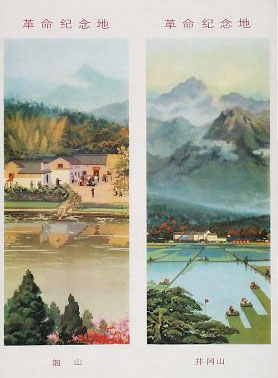Looking out over the beautiful scenery below, swaying bamboo, azaleas and landscaped lakes, I couldn’t help congratulating Mao Zedong on his choice of a hideout: what could be better than an abundance of fresh water, healthy crops and great scenery on top? I find it difficult to believe that this was once a remote impoverished area, ripe for revolutionary mobilization. Jingganshan is where Mao and his faithful right-hand man Zhu De built up the Red Army almost from scratch, after a number of failed uprisings in nearby Nanchang and Changsha in1927.
A Brief History

Mao used his stay in Jinggangshan to put into practice his ideas on rural revolution; testing what type of peasants would support revolution – generally the poorest ones – and which peasants would oppose it. Quite often, the analysis simply came down to whether the peasant owned a pig or not. Any pig-owning peasant could be considered rich, and therefore reactionary. Besides theorizing, Mao relentlessly worked on consolidating his position in power, ruthlessly exterminating any opposition, which resulted in the deaths of thousands of loyal members of the Chinese Communist Party (CCP).

Still, Mao found his fortunes in Jinggangshan rise and fall several times. He was successful in repelling efforts by Chiang Kai Shek’s Nationalist Army to take Jinggangshan by using guerrilla tactics to make up for the double drawback of the Red Army’s inferior numbers and the Nationalists’ modern weaponry. However, he found his position in the CCP continually challenged, especially when the party leadership was forced out of the cities and moved into Jinggangshan. They often criticised Mao over his military tactics, and eventually they won the day. Mao was sidelined and the CCP leadership, under the instruction of Russian advisors, decided to abandon the guerrilla strategy and engage the Nationalist forces head on. The consequences were disastrous and resulted in a series of heavy reversals for the Communists. Eventually, finding themselves completely surrounded, the Communist forces broke out of their Jinggangshan stronghold and embarked upon what became known as the Long March.
Jinggangshan Today

Today, Jinggangshan is a must- see tourist hotspot for millions of Chinese. However, the reasons for visiting have radically changed over the years. Long gone are the days when millions of Red Guards would descend upon the town to pay homage to the Great Helmsman. These days, tourists come to enjoy Continue reading “Jinggangshan 井冈山 ( The red Cradle 红色摇篮)”


